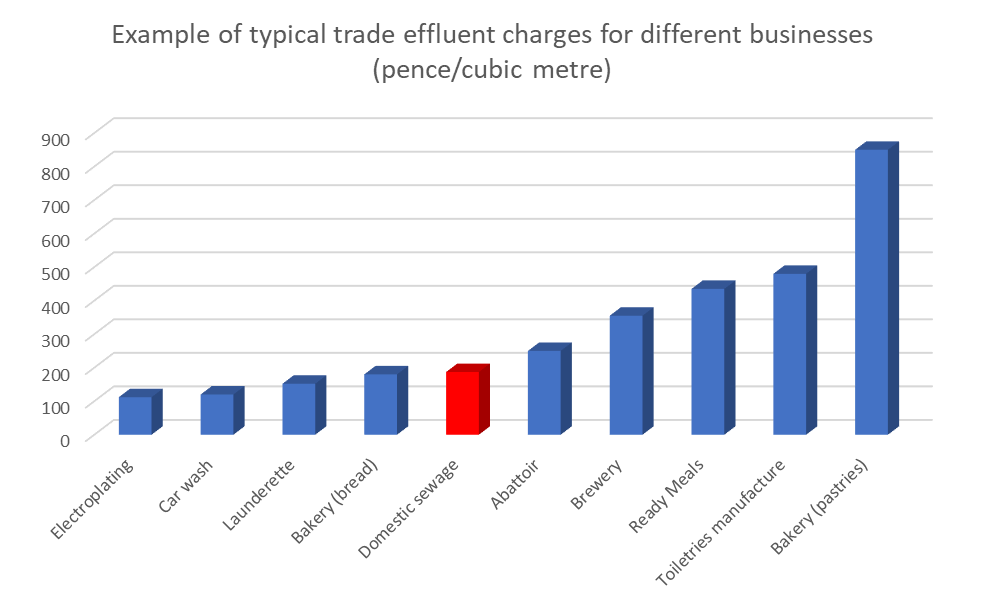Trade effluent charges
Trade effluent charges apply to businesses with a consent to discharge. These charges relate to the cost of using the sewer network and treatment at the sewage works
Charges vary depending on the wholesaler area and the volume and strength of trade effluent discharged. In some areas an additional trade effluent reservation or consent capacity charge may apply.
If the regular monitoring of the discharge is required there may also be a charge for trade effluent sampling and analysis.
The Mogden formula (link to Jargon Buster) is an industry wide formula used to calculate trade effluent charges. The formula compares the strength of the trade effluent discharged with standard sewage. Trade effluent that is weak in strength such as vehicle washing, cooling or rinse water requires less treatment and may be charged at a lower rate than domestic sewage. Higher strength trade effluent for example from food manufacturing or cosmetics production requires more treatment and therefore the charge will be significantly higher.

Trade Effluent Volume
The volume of trade effluent discharged needs to be calculated for billing and to monitor compliance with consent limits. One or more of the following methods is agreed with the wholesaler and retailer:
- Direct measurement of the discharge using a trade effluent flow meter.
This may be a requirement of the consent where it is the responsibility of customer to provide, maintain and calibrate suitable flow measurement.
The type flow measurement system will be site specific and depend on several factors including trade effluent drainage arrangements.
water2business can provide and install a wide variety of flow meters to the latest British and MCerts Standards and arrange independent calibration.
Trade effluent flow data can be hosted on our webportal alongside water supply data with the ability to set high usage alarms and track usage every 15 minutes:

- Use of metered water supply consumption less agreed allowances for domestic sewage and process losses.
- Private sub-metering of water supply to a process less applicable allowances
- water2business can arrange supply and installation of suitable metering
- Calculated discharge
For example calculated or estimated from rainfall figures and surface areas from which the surface water runs off.
Trade Effluent Strength Assessment
The strengths which determine the charging rate in the Mogden formula are generally Suspended Solids and Settled Chemical Oxygen Demand (COD)
There is a significant variation in how strengths are calculated and used for billing and therefore it is best to check with water2business
Examples of different approaches are:
Standard strengths
- Published in a Wholesaler’s Charges Scheme
- Generally for lower risk discharges
- Typically vehicle washing and launderettes.
Agreed Strengths
May be used in the following scenarios:
- Batch discharges
- Where it is difficult to take representative samples of discharge
- Small/low risk discharges
Determined by a sampling study or other available information
Samples – annual fixed strength
- Samples taken throughout a year are used to determine a representative charging strength for the following year.
Samples – actual / rolling or period averages
- Samples taken during a year are used for the periods in which they are taken.
- Rolling or period averages may be used (e.g. 3, 6 or 12 months).
A standard effluent strength can apply to certain categories of trade such car washes and launderettes.
Composite Sampling
If regular samples are taken for billing it is important that they are taken from the agreed sampling point and a representative sample is obtained.
The quality of many trade effluent discharges can vary which means that if spot samples are taken for billing this may not be an accurate assessment of overall effluent quality. For example, if samples are always taken during the working day and you discharge overnight the trade effluent charging strength may not fairly reflect your overall discharge.
Automatic composite sampling over 24 hours is the preferred method to calculate average strengths for billing. This can be time averaged where a fixed volume of effl.uent is taken at equal time intervals to produce a bulk sample that is analysed.
Best practice is to link a trade effluent flow meter to an automatic sampling equipment to obtain a flow-proportional sample over 24 hours. See trade effluent services – automatic sampling for more information
water2business can carryout trade effluent surveys using portable automatic sampling equipment to establish whether your business could reduce trade effluent charges using this technology. We can also provide the latest MCerts approved portable or fixed automatic sampling equipment at competitive rates – link.
Waste Minimisation
A blitz type waste minimisation audit carried out by water2business will identify the sources of high strength wastewater within your factor. Options for minimisation, segregation or treatment of these waste streams will be provided helping your business to reduce costs and become more sustainable. View our trade effluent services for more information.
Trade Effluent Treatment
It may be necessary to install on-site effluent treatment to comply with consent limits.
water2business can undertake an independent effluent treatment option review to identify whether on-site treatment would be cost effective and calculate payback periods. View our trade effluent services for more information.
